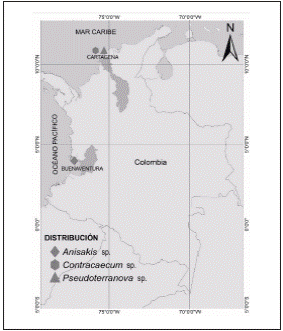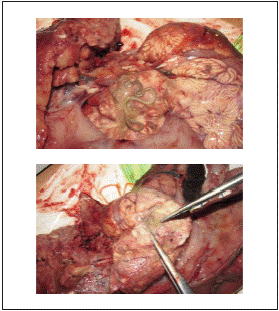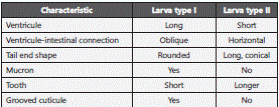Introduction
Anisakidosis is a parasitic disease caused by nematode larvae of the genus Anisakis, Pseudoterranova, Contracaecum and Hysterothylacium, which belong to the Anisakidae family 1-3. The adult form of these nematodes is found in the intestines of marine mammals where their eggs are excreted through the mammals’ feces into the sea. Once in the water, the larval stages L1 and L2 develop. These L2-stage larvae are then ingested by small crustaceans where the larvae mature into the L3 stage. The infected crustaceans are ingested by fish, where these L3 larvae continue to grow. The life cycle is completed when the infected fish are ingested by marine mammals, in which the larvae reach their L4 form and then adulthood. Human beings are simply accidental hosts through the consumption of either raw or undercooked fish or crustaceans infected with L3-stage larvae4.
Generally, a single larva can embed itself in the mucus of the esophagus, stomach, duodenum, jejunum, ileum or colon, causing gastric or intestinal anisakidosis, moderate and severe allergic reactions, or gastro-allergic symptoms4,5.
Most cases of anisakidosis are concentrated in Spain and Japan and the number of reported cases globally is increasing, favored by the popularity of Japanese and Mediterranean cuisine where raw fish is consumed4. One of the first reports of gastric anisakidosis in South America was made in Peru in 1999, caused by Anisakis spp.6. In Chile, cases of the disease caused by L4 forms of Pseudoterranova decipiens have been recorded7. It is possible that anisakidosis is underdiagnosed in the South Amercian regions because its symptoms are similar to pathologies such as appendicitis, gastric ulcers, intestinal obstruction, Crohn’s disease, submucosal tumors, and other intestinal parasites and food allergies5.
During the literature review, no cases of anisakidosis had been reported in Colombia. However, the global distribution of this disease, the annual whale migration to the Colombian Pacific and the increase in the consumption of exotic dishes such as sushi7,8 are factors that could favor the presence of the nematode and the development of anisakidosis.
In Latin America, there are reports of fish species parasitized with anisakids in Argentina, Chile, Peru, Brazil, Venezuela and Mexico9-12.
The present study was carried out on armed snook fish, caught by artisanal fishing methods in Buenaventura, the main fishing port of Colombia on the Pacific coast. The city has an extensive coastal area and abundant artisanal fishing, one of the main sources of employment and food for the populations of the Pacific coast13. Fish caught from this region contribute 80% of the total fish consumed in the country, with an average annual catch of between 400 and 500 thousand tons, sold either fresh, frozen or cured14.
The armed snook is a species of significant economic importance and is a preferred species for consumption by the local population15. It is distributed along the tropical and subtropical coasts of the Pacific and the American Atlantic. They are demersal, semi-quadrilateral, euryhaline fish that feed on crustaceans and small fish16 - the very fauna involved in the life cycle of anisakids as carriers of L3 larvae, the infective stage of Anisakis9.
The objective of this study was to determine the presence of anisakid nematode larvae in the armed snook (Centropomus armatus) caught in Buenaventura.
Methods & Materials
Fifteen armed snook fish (C. armatus) from Buenaventura, donated by the E.A.T. Fishery Advisors company of the Colombian Fisheries Observer Program, were transferred to the histology laboratory of the Universidad del Valle (Cali, Colombia), where they were sectioned and examined under stereoscopic microscopy (Olympus SZM-45) (Figure 1 ).
The nematodes found were extracted and stored in 70% alcohol and were subsequently diaphanized in glycerin solutions, according to the Moravec & Scholz protocol17. Observations and photography were carried out using a light microscope (Leica DM 750), using the Leica Application Suite program (LAS v 3.8).
In order to differentiate between the genera of the Anisakidae family, identification by classical taxonomy was performed, as summarized in Table 1. 18.
Once identified morphologically, the anisakids were counted and grouped by host. The parameters of infection, prevalence and average abundance were calculated, following the methodology of Bush et al.19.
For histochemical processing, the parasites were cross-sectioned and steeped in paraffin (Rodrígues protocol with modified impregnation times)20. Paraffin blocks were sectioned (Leica RM 2245 microtome) at a thickness of 5 mm. Slides were stained with Hematoxylin-Eosin and mounted using Consult Mount (Shandon) medium for characterization.
Results
Anisakis larvae were identified parasitizing primarily in the mesentery of the C. armatus. The larvae presented characteristics of the genus Anisakis: a whitish color with crosssectional cuticular grooves (Figure 2); a mouth composed of three lips surrounding the cuticular tooth; a posterior extremity with conical termination and an absence of mucron; a mid-section formed by an esophagus, ventricle and intestine arranged along the longitudinal axis of the larva, characteristic of larvae of the Anisakis sp. (Figure 2 ).

Figure 2 Larva (L3) type II of Anisakis sp. isolated from armed snook fish (C. armatus). a. Front end 40X, b. Back end 40X, c. Medium portion - 20X, dc. cuticular tooth, pa. anal pore, e. esophagus, v. ventricule, i. intestine
The prevalence was 42% and the mean abundance was 2.8. In the histological preparations made at the intestinal level, bilateral symmetry, intestinal lumen in the form of grooves (Figure 3a), hypodermis and a muscular layer were all observed. In all samples the cuticle was observed, a characteristic of the nematodes (Figure 3 c and Figure 3d).
Discussion
In this study we report type II larvae of the genus Anisakis in armed snook fish (C.armatus) caught in Buenaventura, based on the characteristics described by Shiraki in 197421.
In Colombia, there is only one report of the presence of nematodes from the anisákidae family, genus Contracaecum, that of nematodes present in the common snook or sargeant snook fish (Centropomus undecimalis) from the Bay of Cartagena in the Caribbean Sea16. In the same bay, Contracaecum sp. was found in both catfish (Sciades herzbergii) and horse mackerel (Caranx hippos) 16. In the parassi mullet fish (Mugil incilis) 16, Contracaecum and Pseudoterranova22 were found. The distribution of these species is presented in Figure 4.

Figure 4 Distribution of anisakid nematodes in the Colombian coasts. Anisakis sp. (◊). report made by the current study for the Pacific Ocean. Contracaecum sp. (□), Pseudoterranova sp. (∆) in the bay of Cartagena, Caribbean Sea.
In continental waters, Contracaecum sp. has been recorded in the trahira fish (Hoplias malabaricus) caught in the Amazon River and in different river basins of northern Colombia23,24, in the rubio fish (Salminus affinis) caught in the Sinú and San Jorge rivers, in trahira (H.malabaricus) from the Cienaga Grande marshlands in Córdoba and in the Trans-Andean shovelnose catfish fish (Sorubim cuspicaudus) commercialized in the department of Sucre25.
Our research constitutes the first report of the genus Anisakis in Colombia found in the armed snook fish (C.armatus), a parasite associated with the largest number of cases of anisakidosis in the world. It is already identified as a public health concern in Japan and Spain where it is associated with allergic reactions (type I hypersensitivity) and gastroalgesia. Parasitic identification was made using low-cost techniques such as diaphanization and histochemistry, both safe and readily accessible for clinical diagnostics laboratories20,26. Histochemistry provided a complementary means of parasite identification through the analysis of internal structures such as nerve cords, intestines, and the muscular layer with its contractile and non-contractile section. Although this technique is not commonly used in parasitology, we can find studies such as those of Zuloaga, Zullo et al in which similar processes of identification were employed27,28
Although the diagnosis of anisakidosis in humans is typically made by endoscopy, the accurate morphological identification of the parasite requires the use of histochemical techniques, either when processing biopsies from cysts in the intestine or granulomas that are formed with chronic infection. In addition, A. simplex can penetrate the intestinal wall and enter the abdominal cavity, lodging in any of the organs located there, cases that also require a biopsy5,29,30.
The presence of such parasites in armed snook fish is concerning because it is a species in great demand by commercial fisheries15 and, on Colombia’s Pacifiic coast, it is caught mainly by artisanal fishing, where the total production of this means of fishing represents approximately 60% of the total current catch in the Colombian Pacific, mainly in Buenaventura29.
This research has yielded important results that can be used to guide public policy in the fisheries, food quality and health sectors, with respect to a potential emerging disease in our country.

















